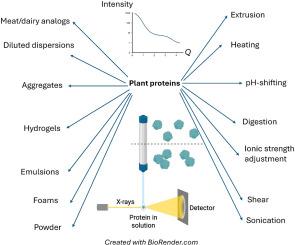Probing multiscale structure of plant protein-based food system: Application of small-angle X-ray and neutron scattering (SAXS/SANS)
IF 11
1区 农林科学
Q1 CHEMISTRY, APPLIED
引用次数: 0
Abstract
Plant-based foods are gaining momentum as sustainable and health-conscious alternatives to animal-derived products. Understanding the structural organization of plant protein systems from molecular to mesoscopic scales is essential for designing products with desirable texture, stability, and nutritional performance. Small-angle X-ray scattering (SAXS) and small-angle neutron scattering (SANS) are powerful, non-destructive techniques that provide detailed insights into the hierarchical structures of these systems under realistic, hydrated conditions. This review summarizes recent advances in the use of SAXS and SANS to study plant-based gels, foams, emulsions, meat analogues, dairy alternatives, and in vitro digestion. These techniques reveal critical information on protein aggregation, network formation, interfacial structuring, and digestion dynamics, often inaccessible by conventional methods. We also outline future research directions, including expanding to non-thermal gelation pathways, integrating in situ processing environments, coupling with complementary techniques, and leveraging AI for structural interpretation. SAXS and SANS are poised to play a central role in the rational design of next-generation plant-based foods with optimized functional and sensory attributes.

植物蛋白基食物体系的多尺度结构探测:小角x射线和中子散射(SAXS/SANS)的应用
植物性食品作为可持续和注重健康的动物源性产品替代品的势头正在增强。了解植物蛋白系统从分子到介观尺度的结构组织对于设计具有理想质地、稳定性和营养性能的产品至关重要。小角度x射线散射(SAXS)和小角度中子散射(SANS)是一种强大的非破坏性技术,可以在现实的水合条件下详细了解这些系统的分层结构。本文综述了SAXS和SANS在植物性凝胶、泡沫、乳剂、肉类类似物、乳制品替代品和体外消化研究中的最新进展。这些技术揭示了蛋白质聚集、网络形成、界面结构和消化动力学的关键信息,这些信息通常是传统方法无法获得的。我们还概述了未来的研究方向,包括扩展到非热凝胶途径,整合原位加工环境,与互补技术耦合,以及利用人工智能进行结构解释。SAXS和SANS将在优化功能和感官属性的下一代植物性食品的合理设计中发挥核心作用。
本文章由计算机程序翻译,如有差异,请以英文原文为准。
求助全文
约1分钟内获得全文
求助全文
来源期刊

Food Hydrocolloids
工程技术-食品科技
CiteScore
19.90
自引率
14.00%
发文量
871
审稿时长
37 days
期刊介绍:
Food Hydrocolloids publishes original and innovative research focused on the characterization, functional properties, and applications of hydrocolloid materials used in food products. These hydrocolloids, defined as polysaccharides and proteins of commercial importance, are added to control aspects such as texture, stability, rheology, and sensory properties. The research's primary emphasis should be on the hydrocolloids themselves, with thorough descriptions of their source, nature, and physicochemical characteristics. Manuscripts are expected to clearly outline specific aims and objectives, include a fundamental discussion of research findings at the molecular level, and address the significance of the results. Studies on hydrocolloids in complex formulations should concentrate on their overall properties and mechanisms of action, while simple formulation development studies may not be considered for publication.
The main areas of interest are:
-Chemical and physicochemical characterisation
Thermal properties including glass transitions and conformational changes-
Rheological properties including viscosity, viscoelastic properties and gelation behaviour-
The influence on organoleptic properties-
Interfacial properties including stabilisation of dispersions, emulsions and foams-
Film forming properties with application to edible films and active packaging-
Encapsulation and controlled release of active compounds-
The influence on health including their role as dietary fibre-
Manipulation of hydrocolloid structure and functionality through chemical, biochemical and physical processes-
New hydrocolloids and hydrocolloid sources of commercial potential.
The Journal also publishes Review articles that provide an overview of the latest developments in topics of specific interest to researchers in this field of activity.
 求助内容:
求助内容: 应助结果提醒方式:
应助结果提醒方式:


